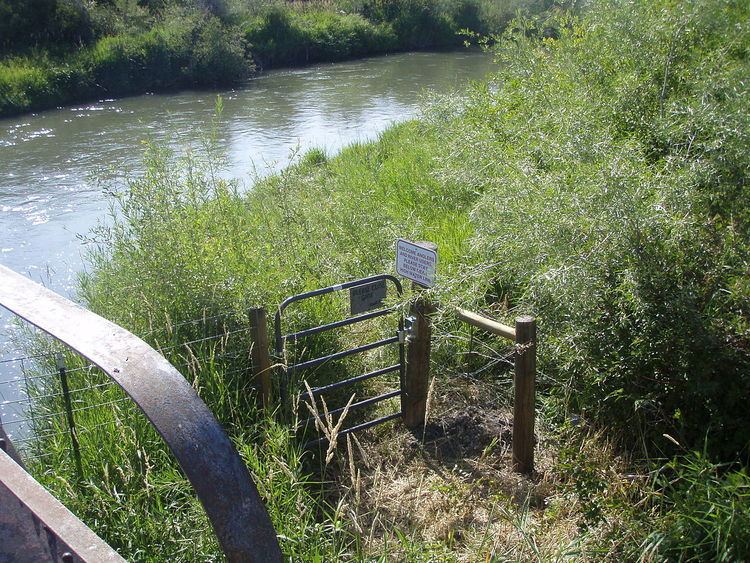The Montana Stream Access Law says that anglers, floaters and other recreationists in Montana have full use of most natural waterways between the high-water marks for fishing and floating, along with swimming and other river or stream-related activities. In 1984, the Montana Supreme Court held that the streambed of any river or stream that has the capability to be used for recreation can be accessed by the public regardless of whether the river is navigable or who owns the streambed property. On January 16, 2014, the Montana Supreme Court, in a lawsuit filed by the Public Land/Water Access Association over access via county bridges on the Ruby river in Madison County, Montana reaffirmed the Montana Stream Access Law and the public's right to access rivers in Montana from public easements.
The core law creating the Montana Stream Access law began with Article IX, section 3 of the 1972 Montana Constitution, which addressed state ownership of Montana waters. In 1984 in Montana Coalition for Stream Access, Inc. v. Curran, the Montana Supreme Court held that “under the public trust doctrine and the 1972 Montana Constitution, any surface waters that are capable of recreational use may be so used by the public without regard to streambed ownership or navigability for nonrecreational purposes.” This decision was expanded upon in the same year by Mont. Coalition for Stream Access, Inc. v. Hildreth. Both cases noted that streambed access did not imply that the public had a right to cross private lands to access streams. Following Curran and Hildreth, the Montana Legislature enacted the Stream Access Law in 1985. An Attorney General's opinion added trapping to the list of permissible recreational uses.
The law creates two classifications of waters capable of recreational use: Class I and Class II. Class I are waters which are capable of recreational use and have been declared navigable or which are capable of specific kinds of commercial activity including commercial outfitting with multi-person watercraft. Class II waters are all other rivers and streams capbable of recreational use that are not Class I waters.
Class I Waters
Kootenai River DrainageKootenai River - from Libby Dam to the Idaho borderLake Creek - from Chase cut-off road to its confluence with the Kootenai RiverYaak River - from Yaak Falls to its confluence with the Kootenai RiverFlathead River DrainageSouth fork of the Flathead - from Youngs creek to Hungry Horse reservoirMiddle fork of the Flathead - from Schaffer creek to its confluence with the Flathead RiverFlathead River (mainstem) - to its confluence with the Clark Fork RiverClark Fork of the Columbia River DrainageClark Fork River - from Warm Spring Creek to the Idaho borderNorth Fork of the Blackfoot - from highway 200 east of Ovando to its confluence with the mainstem of the Blackfoot RiverBlackfoot River - from the Cedar Meadow fishing access site west of Helmville to its confluence with the Clark Fork RiverBitterroot River - from the confluence of the East and West forks to its confluence with the Clark Fork RiverRock Creek - from the confluence of the West fork to its confluence with the Clark Fork RiverMissouri River DrainageMissouri River - from Three Forks to the North Dakota borderBeaverhead River - from Clark Canyon Dam to its confluence with the Jefferson RiverBig Hole River - from Fishtrap fishing access downstream from Wisdom to its confluence with the Jefferson RiverGallatin River - from Taylors Fork to its confluence with the Missouri RiverJefferson River - to its confluence with the Missouri RiverMadison River - from Quake Lake to its confluence with the Missouri RiverDearborn River - from Highway 431 bridge to its confluence with the Missouri RiverSun River - from Gibson Dam to its confluence with the Missouri RiverSmith River - from the Camp Baker Fishing Access site near Ft. Logan to its confluence with the Missouri RiverMarias River - from Tiber Dam to its confluence with the Missouri RiverJudith River - from the confluence with Big Spring Creek to its confluence with the Missouri RiverYellowstone River DrainageYellowstone River - from Yellowstone National Park to the North Dakota borderBighorn River - from Yellowtail Dam to its confluence with the Yellowstone RiverTongue River - from Tongue River Dam to its confluence with the Yellowstone RiverPublic Land/Water Access Association - The mission of the association is to maintain, restore, and perpetuate public access to the boundaries of all Montana public land and waters.Montana River Action - The clean flowing waters of Montana belong to the people and are held in trust by the State for a pollution-free healthful environment guaranteed by our Montana Constitution. Montana River Action’s mission is to protect and restore rivers, streams and other water bodies.Montana Wildlife Federation - Dedicated to conservation and preservation of Montana's wildlife, lands, waters and Montana fair-chase hunting and fishing heritage; Prioritizing public access to public wildlife and public lands.Property and Environment Research Center (PERC) - Improving environmental quality through property rights and markets.Montana Farm Bureau Federation Agricultural organization supporting interests of irrigators and landowners.
